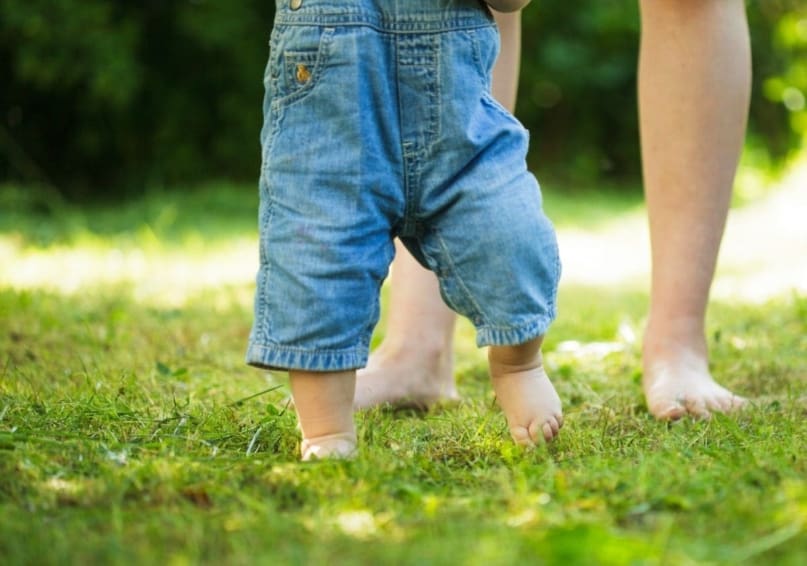
What is intoeing?
Most people’s feet point straight ahead or outward. Some people, however, have feet that point inward. This is called intoeing. It is also called “pigeon toes.” Intoeing is very common in young children. Most of the time, intoeing goes away without treatment. In a few children, it doesn’t get better on its own and must be treated.
Symptoms of intoeing
When your child has intoeing, their feet point inward toward each other. The condition usually does not cause pain or any other symptoms.
What causes intoeing?
It’s not exactly clear why some children develop intoeing. Family history could play a role. A lack of space in the womb can also cause some bones to rotate.
There are three causes of intoeing in healthy children.
Internal tibial torsion. This is the most common cause of intoeing. Internal tibial torsion is a twist in the tibia (the leg bone between the knee and the ankle). Some inward twist of the tibia is normal in babies. Usually this twist straightens out during the baby’s first year. In some children, the twist doesn’t straighten enough for the feet to point straight ahead or outward. These are the children who intoe when they begin walking. Leg bones usually continue to grow straighter until the child is 6 to 8 years old.
Excess femoral anteversion. Excess femoral anteversion is an inward twist in the femur (thigh bone). All babies are born with some inward twist of the thigh bone. This cause of intoeing usually shows up in children between 2 and 4 years of age. It can get worse during early childhood.
Metatarsus adductus. Metatarsus adductus is a curve in the foot. It causes the toe to point inward. It is commonly seen in newborns and infants. The curve in the foot is probably caused before the baby is born. The feet are pressed into this position inside the uterus. In 9 out of 10 children with this problem, the feet straighten as the child grows up.
How is intoeing diagnosed?
Your doctor will look at your child’s foot. They will watch the way your child walks. They may order tests, such as X-rays. This will help them determine if any bones are rotated.
Can intoeing be prevented or avoided?
There is nothing that can be done to prevent intoeing in your child.
Intoeing treatment
Treatment for your child’s intoeing depends on the cause. In most cases, treatment is not necessary. The problems resolve over time.
Internal tibial torsion
Most doctors don’t give any treatment for internal tibial torsion in young children. Braces and special shoes are not helpful. They are expensive. Children often don’t like to wear them, so they are seldom used. In a small number of children, the twist in the tibia doesn’t go away. Even if the twist remains, it hasn’t been shown to cause joint damage, arthritis, or problems with running and jumping.
Sometimes appearance is a problem. In this case, the treatment is surgery to cut the bones and turn (rotate) them outward, so the feet point straight. Very few children have to have this surgery. This is something that must be carefully discussed with your child’s doctor.
Excess femoral anteversion
Excess femoral anteversion usually gets better by itself. In most children, the feet will point straight ahead or outward by the time they are 6 to 8 years old. Braces or shoe modifications typically won’t help. A few children with a very strong inward twist of the thigh bone may need to have surgery. The bone is cut and twisted outward, so the feet will point straight ahead. Surgery is only considered in very severe cases.
Metatarsus adductus
Your doctor may show you how to stretch the baby’s foot to help the foot get straighter. If the foot shape is very curved or the curve doesn’t go away, your doctor may treat your baby by putting casts or braces on their feet. This will help stretch them into a straight position. If the feet still have some curve after treatment, it will not cause any problems with running and playing. It is not painful.
Living with intoeing
Intoeing usually doesn’t cause serious problems, even if it doesn’t go away by itself. Sometimes children have problems getting shoes that fit, because of the curve of their feet. This fitting problem might make parents consider treatment for their child. Intoeing doesn’t cause arthritis or clumsiness.
Questions to ask your doctor
- What is the likely cause of my child’s intoeing?
- How severe is my child’s intoeing?
- What is the best treatment option?
- Will my child need to wear a brace or special shoes?
- Is there anything I can do at home to help treat my child’s intoeing?
- Is it safe for my child to run, jump, etc.? What kinds of activities are okay?
- Will intoeing cause long-term problems for my child?
![]()
Copyright © American Academy of Family Physicians
This information provides a general overview and may not apply to everyone. Talk to your family doctor to find out if this information applies to you and to get more information on this subject.









